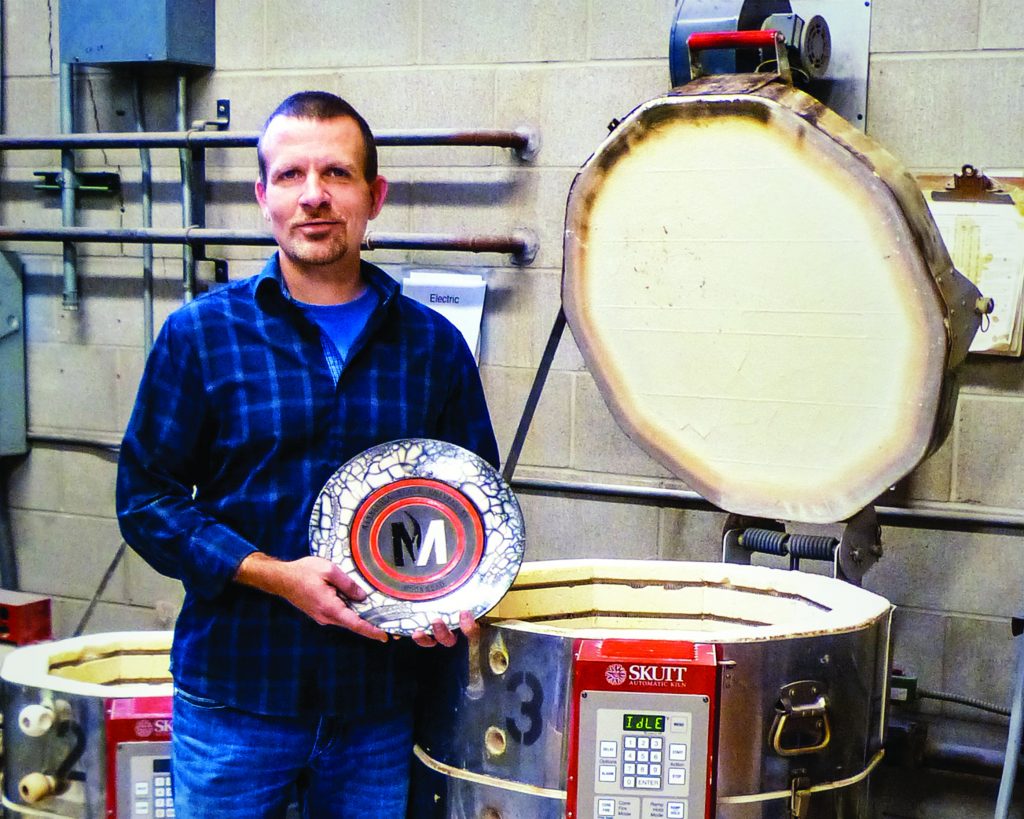
Firing clay is as natural as breathing to Brad Bachmeier, art professor at Minnesota State University Moorhead and outspoken advocate for professional artists — here, with one of the MSUM Distinguished Alumni awards to be presented at homecoming Saturday. Brad’s studio is one of those featured during this weekend’s sixth annual Studio Crawl this weekend. (Photo/Nancy Hanson)
Nancy Edmonds Hanson
hansonnanc@gmail.com
“That cliché about ‘starving artists’ drives me crazy,” proclaims Brad Bachmeier, who isn’t one. “Lazy artists, maybe…. The opportunities are out there, but you have to work to find them.”
After 25 years as both teacher and practicing artist, Brad – coordinator of Minnesota State University’s art education program – is passionate about inspiring students to carve out lives in which they can make both art and a decent living. “Art can change a kid’s life,” he says. “I’ve seen it literally save them. But we need to provide more than techniques. Without hope and information on schools and degrees and vocations, how would they know how far they can go?”
That passion for raising the hopes, goals and visibility of young artists is why the Anamoose, N.D., native, who graduated from his tiny art-free school in a class of 18, has been singled out as the Fargo-Moorhead Visual Artists Association’s member of the year. The passionate arts advocate will be celebrated this weekend during FMVA’s Studio Crawl Saturday and Sunday.
Brad has been inspiring artists to reach higher and go farther in their careers and their communities. After graduating from Minnesota State University Moorhead in 1993, he applied his art education training teaching K-12 art classes in Litchfield, Minn. Five years later, he returned to Fargo-Moorhead at Ben Franklin Junior High School and, in 2003, Fargo North. He came full circle in 2009, when – after completing a master of fine arts degree through the University of North Dakota – he joined the art faculty at MSUM. Today he’s the coordinator of the art education program, accounting for about 65 of the Art Department’s 200 majors, the largest of its kind in the tri-state area.
When he’s not molding future teachers in the classroom, Brad works with clay. At the dawn of his days in the classroom, making and selling pots and platters seemed like a pleasant enough pursuit to fill the months when school wasn’t in session. But Bachmeier Pottery, he says, got serious when his wife, Sue – now a special education teacher at Discovery Middle School – was about to give birth to the third of their four children. She wanted to mother their baby-to-be and two toddler daughters full-time. “That put more pressure on my pottery business,” Brad says now. “Now it had to replace one whole full-time salary.”
And it did. He accelerated his production and began to develop a following. He speaks of “one perfectly normal couple” who followed him from show to show in those early days. “Over three years, they must have bought at least a dozen pieces from me – maybe 15 or 20.” He adds, “I didn’t know what to make of that.”
Brad became a regular at the Downtown Street Fair and other familiar venues during his first years back in Fargo. His growing reputation sprang from his distinctive glazed and textured raku pots. He adapted a traditional Japanese technique in which the clay is low-fired in a pit fueled by sawdust or wood instead of in an electric kiln, then glazed when it’s red hot. He has moved on since then to take part in some of the Midwest’s most prestigious juried art shows – this year, including Park City, Utah; Chicago; Jackson Hole, Wyo.; Madison, Wis.; Des Moines, Ia.; and Denver’s Cherry Creek, one of the top five in the nation.
He credits a casual conversation with another art-fair potter for the insight that opened up new markets. Looking over Brad’s wares, all designed to rest on flat surfaces, the sage observed, “Homes are 70 percent walls and only 30 percent surfaces. Why limit yourself?”
Things that can be hung – plates and platters – opened up a new market for the enterprising potter. But not until the mid-2000s, as he worked on his MFA degree at UND, did he consider taking on the walls themselves.
He credits Katie McCleary, a nationally known brick artist then in Grand Forks, with introducing him to the possibilities of truly monumental art – designing, building and firing permanent installations of a size far beyond most potters’ ambitions. He was immediately intrigued by the painstaking process of creating three-dimensional wall murals of carved and sculpted brick – both its creative possibilities and its potential as permanent public art. Today he’s recognized of just 19 professional brick artists in the country.
His first project was the wall that still welcomes visitors at the main entrance to Fargo North, where he taught at the time. That led to his first major commission: a 14-by-6-foot mural encompassing the story of the North Dakota National Guard in its headquarters at Camp Grafton. The matrix of some 500 unfired bricks was stacked, then sculpted into 3-D portrayals of figures from military history.
After firing, they were hauled to Devils Lake, where brick masons stood ready to install them. Not quite all of them, though. “As they were getting ready, I realized one was missing – one right in the center,” he says. “I panicked! I called my wife, and she found it nicely wrapped in one of our vehicles. I’d taken it to school to show the kids and forgotten to put it back.” Sue saved the day by driving it north … very quickly.
Nor is the initial design process as straightforward as working on canvas or paper. “All clay shrinks. When it has to fit a certain space, you need to know how much,” he explains, “as well as its wet and dry weight for the structural engineers. I determined that this clay would shrink 6.75 percent. It took hours and hours to figure out.” He adds sincerely, “I hate math.”
His biggest public art project to date coils around the playground at Fargo’s Madison Elementary School. Funded by the Legacy Children’s Foundation, among others, the 30-foot-long lizard is said to be the largest brick sculpture in North Dakota. Nine thousand bricks were employed in the low-rise reptile, designed for kids to climb and play on. “It was huge. It took an entire summer, and by the time we got it installed, over 300 people had touched it.”
Always searching for new opportunities, Brad has taken on new adventures as an artist in residence. He’s spent two-week stints over four years at Lewis and Clark State Park in western North Dakota and three national parks and monuments – Grand Canyon National Parashant Monument, Mesa Verde National Park and the National Petrified Forest. The work he produced there, inspired by natural history and native cultures, is being organized for a national museum tour late next year.
The professor shares these experiences, and others, with avid students and fellow artists on campus and in other venues, like the F-M Visual Artists’ gallery talk at the Plains Art Museum last week. He addressed his favorite topic – making a living as an artist. He’s not just happy to answer questions and share encouragement about the endless possibilities waiting to be uncovered. He’s downright evangelical.
“Only 3 to 4 percent of students who earn their MFAs in art get college teaching jobs,” he reflects. “So what’s the plan for the rest of them?
“I’m looking to push that button a little harder – to share the news that you can make a good living as an artist without also teaching. I know 100 potters in Minnesota who are doing just fine. I know basket-makers, painters, photographers who do, too. You don’t hear about them much in the Midwest, where we’re kind of shy about talking about money, but they’re out there. The possibilities are endless if you’re willing to not only do the art, but do the research.”


